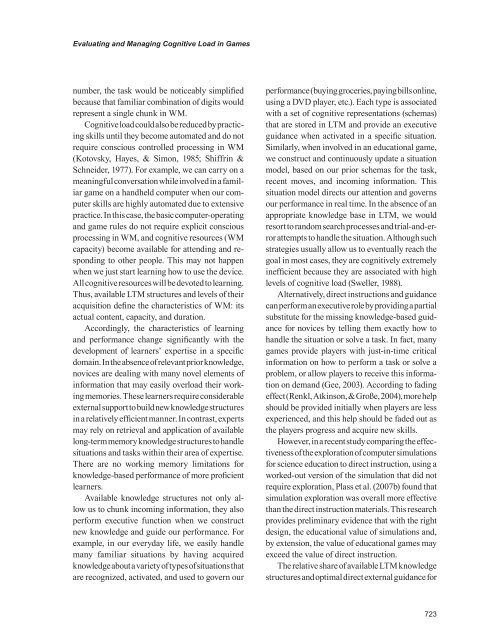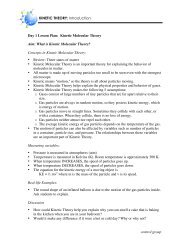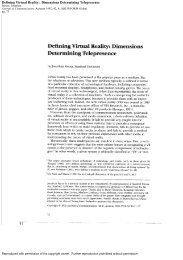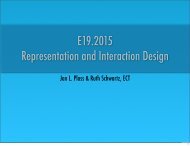Evaluating and managing cognitive load in educational games
Evaluating and managing cognitive load in educational games
Evaluating and managing cognitive load in educational games
Create successful ePaper yourself
Turn your PDF publications into a flip-book with our unique Google optimized e-Paper software.
<strong>Evaluat<strong>in</strong>g</strong> <strong>and</strong> Manag<strong>in</strong>g Cognitive Load <strong>in</strong> Games<br />
number, the task would be noticeably simplified<br />
because that familiar comb<strong>in</strong>ation of digits would<br />
represent a s<strong>in</strong>gle chunk <strong>in</strong> WM.<br />
Cognitive <strong>load</strong> could also be reduced by practic<strong>in</strong>g<br />
skills until they become automated <strong>and</strong> do not<br />
require conscious controlled process<strong>in</strong>g <strong>in</strong> WM<br />
(Kotovsky, Hayes, & Simon, 1985; Shiffr<strong>in</strong> &<br />
Schneider, 1977). For example, we can carry on a<br />
mean<strong>in</strong>gful conversation while <strong>in</strong>volved <strong>in</strong> a familiar<br />
game on a h<strong>and</strong>held computer when our computer<br />
skills are highly automated due to extensive<br />
practice. In this case, the basic computer-operat<strong>in</strong>g<br />
<strong>and</strong> game rules do not require explicit conscious<br />
process<strong>in</strong>g <strong>in</strong> WM, <strong>and</strong> <strong>cognitive</strong> resources (WM<br />
capacity) become available for attend<strong>in</strong>g <strong>and</strong> respond<strong>in</strong>g<br />
to other people. This may not happen<br />
when we just start learn<strong>in</strong>g how to use the device.<br />
All <strong>cognitive</strong> resources will be devoted to learn<strong>in</strong>g.<br />
Thus, available LTM structures <strong>and</strong> levels of their<br />
acquisition def<strong>in</strong>e the characteristics of WM: its<br />
actual content, capacity, <strong>and</strong> duration.<br />
Accord<strong>in</strong>gly, the characteristics of learn<strong>in</strong>g<br />
<strong>and</strong> performance change significantly with the<br />
development of learners’ expertise <strong>in</strong> a specific<br />
doma<strong>in</strong>. In the absence of relevant prior knowledge,<br />
novices are deal<strong>in</strong>g with many novel elements of<br />
<strong>in</strong>formation that may easily over<strong>load</strong> their work<strong>in</strong>g<br />
memories. These learners require considerable<br />
external support to build new knowledge structures<br />
<strong>in</strong> a relatively efficient manner. In contrast, experts<br />
may rely on retrieval <strong>and</strong> application of available<br />
long-term memory knowledge structures to h<strong>and</strong>le<br />
situations <strong>and</strong> tasks with<strong>in</strong> their area of expertise.<br />
There are no work<strong>in</strong>g memory limitations for<br />
knowledge-based performance of more proficient<br />
learners.<br />
Available knowledge structures not only allow<br />
us to chunk <strong>in</strong>com<strong>in</strong>g <strong>in</strong>formation, they also<br />
perform executive function when we construct<br />
new knowledge <strong>and</strong> guide our performance. For<br />
example, <strong>in</strong> our everyday life, we easily h<strong>and</strong>le<br />
many familiar situations by hav<strong>in</strong>g acquired<br />
knowledge about a variety of types of situations that<br />
are recognized, activated, <strong>and</strong> used to govern our<br />
performance (buy<strong>in</strong>g groceries, pay<strong>in</strong>g bills onl<strong>in</strong>e,<br />
us<strong>in</strong>g a DVD player, etc.). Each type is associated<br />
with a set of <strong>cognitive</strong> representations (schemas)<br />
that are stored <strong>in</strong> LTM <strong>and</strong> provide an executive<br />
guidance when activated <strong>in</strong> a specific situation.<br />
Similarly, when <strong>in</strong>volved <strong>in</strong> an <strong>educational</strong> game,<br />
we construct <strong>and</strong> cont<strong>in</strong>uously update a situation<br />
model, based on our prior schemas for the task,<br />
recent moves, <strong>and</strong> <strong>in</strong>com<strong>in</strong>g <strong>in</strong>formation. This<br />
situation model directs our attention <strong>and</strong> governs<br />
our performance <strong>in</strong> real time. In the absence of an<br />
appropriate knowledge base <strong>in</strong> LTM, we would<br />
resort to r<strong>and</strong>om search processes <strong>and</strong> trial-<strong>and</strong>-error<br />
attempts to h<strong>and</strong>le the situation. Although such<br />
strategies usually allow us to eventually reach the<br />
goal <strong>in</strong> most cases, they are <strong>cognitive</strong>ly extremely<br />
<strong>in</strong>efficient because they are associated with high<br />
levels of <strong>cognitive</strong> <strong>load</strong> (Sweller, 1988).<br />
Alternatively, direct <strong>in</strong>structions <strong>and</strong> guidance<br />
can perform an executive role by provid<strong>in</strong>g a partial<br />
substitute for the miss<strong>in</strong>g knowledge-based guidance<br />
for novices by tell<strong>in</strong>g them exactly how to<br />
h<strong>and</strong>le the situation or solve a task. In fact, many<br />
<strong>games</strong> provide players with just-<strong>in</strong>-time critical<br />
<strong>in</strong>formation on how to perform a task or solve a<br />
problem, or allow players to receive this <strong>in</strong>formation<br />
on dem<strong>and</strong> (Gee, 2003). Accord<strong>in</strong>g to fad<strong>in</strong>g<br />
effect (Renkl, Atk<strong>in</strong>son, & Große, 2004), more help<br />
should be provided <strong>in</strong>itially when players are less<br />
experienced, <strong>and</strong> this help should be faded out as<br />
the players progress <strong>and</strong> acquire new skills.<br />
However, <strong>in</strong> a recent study compar<strong>in</strong>g the effectiveness<br />
of the exploration of computer simulations<br />
for science education to direct <strong>in</strong>struction, us<strong>in</strong>g a<br />
worked-out version of the simulation that did not<br />
require exploration, Plass et al. (2007b) found that<br />
simulation exploration was overall more effective<br />
than the direct <strong>in</strong>struction materials. This research<br />
provides prelim<strong>in</strong>ary evidence that with the right<br />
design, the <strong>educational</strong> value of simulations <strong>and</strong>,<br />
by extension, the value of <strong>educational</strong> <strong>games</strong> may<br />
exceed the value of direct <strong>in</strong>struction.<br />
The relative share of available LTM knowledge<br />
structures <strong>and</strong> optimal direct external guidance for<br />
723








